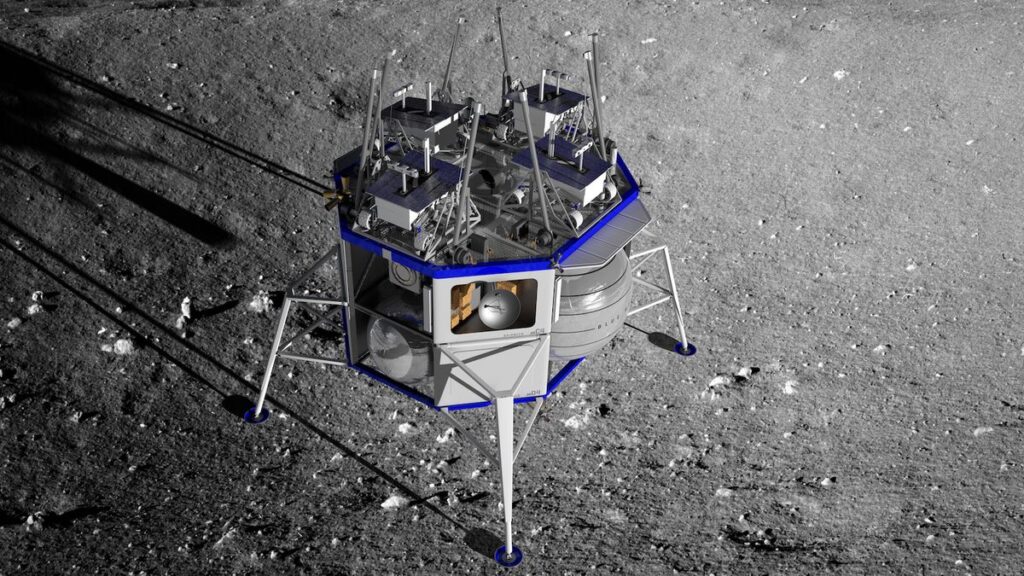
Audience
- Sentiment: positive
- Political Group: supporters of space exploration
- Age Group: young adults and students
- Gender: all genders
Overview
- Blue Ghost lunar lander mission set to land on the Moon on March 2, equipped with 10 scientific instruments to study lunar features.
- Part of NASA’s Artemis program aimed at returning humans to the Moon and preparing for Mars exploration.
- The mission faces challenges but represents perseverance and potential breakthroughs in our understanding of the Moon.
The Journey of Firefly Aerospace’s Blue Ghost Lunar Lander
Imagine gazing up at the bright, shining Moon floating in the night sky. It’s something we’ve all done at one point or another, whether we’re staring out of our bedroom windows or taking a walk outside to catch a glimpse of the stars. But what if I told you that we are getting closer to understanding this celestial body like never before? That’s where the Blue Ghost lunar lander comes into play. Managed by Firefly Aerospace, the Blue Ghost is on an exciting mission. It’s all set to land on the Moon’s surface on March 2, and believe me, that’s a big deal!
What Makes Blue Ghost Special?
First off, let’s get to know the Blue Ghost a bit more. Consider it a robust science lab equipped with some of the coolest technologies we’ve developed so far. This lander is not just a hunk of metal; it’s packed with 10 scientific instruments that are specially designed to gather important data about the Moon. These instruments will study various aspects like lunar heat flow, magnetic fields, and even soil composition. Each of these studies contributes to our understanding of how the Moon was formed and what it’s made of.
One area of focus is the Mare Crisium, a dark plain on the Moon’s surface. Think of this as a giant parking lot on the Moon—completely flat and easy to land on. The findings in this area might help scientists learn more about the Moon’s history and its geological processes. Understanding this could help us unlock the secrets of our own planet as well!
The Mission’s Journey So Far
Recently, Blue Ghost achieved a significant milestone by successfully lowering its orbit to 75 miles above the Moon. Just imagine that: floating above the Moon, looking down at the surface! This maneuver is particularly crucial because it positions the lander for its impending landing. However, it’s not all smooth sailing. During this transitioning period, we may temporarily lose communication with the lander. Think of it like losing cell service when you’re in a remote area—frustrating but a temporary glitch in the grand scheme of things.
Now, you might wonder why all of this matters. Blue Ghost’s mission isn’t just a standalone project; it’s part of a larger initiative by NASA called the Artemis program. The goal here is monumental: to return humans to the Moon in the near future, preparing us for longer journeys to Mars and beyond. By testing new technologies like those on Blue Ghost, NASA is paving the way for human spaceflight and exploration. We might even see astronauts walking on the Moon again, perhaps before you graduate high school!
Challenges of Lunar Exploration
Despite the excitement and potential breakthroughs, lunar exploration is filled with challenges. The Blue Ghost mission comes after a rollercoaster of results from various private lunar landers. Some have successfully landed but faced significant difficulties in executing planned operations, while others have failed to even make a controlled landing. This unpredictability is part of why exploration is so thrilling yet so tough.
Imagine trying to throw a dart at a target while blindfolded—you know where the target is supposed to be, but actually hitting it is a completely different story! Similarly, landing a spacecraft on the Moon requires precision and expertise. The different challenges faced by previous missions remind us of how important it is to keep trying, learning from our mistakes, and pushing boundaries.
The Bigger Picture
You might think that exploring the Moon is primarily about collecting rocks and taking pretty pictures. While those are certainly parts of it, the bigger picture tells a much more fascinating story. Understanding our nearest celestial neighbor helps us learn not just about the Moon, but also about Earth and the overall solar system.
The Moon serves as a kind of time capsule, preserving clues about the history of our solar system. By studying its soil and geological features, scientists can piece together how the planets formed and evolved over billions of years. Plus, as humanity seeks new frontiers, the Moon may act as a launch pad for missions to Mars and deep space.
The Importance of Perseverance
Let’s get a little personal here. When I think about Blue Ghost and what it represents, I’m reminded of moments in life when we all face challenges—like preparing for a big test or trying out for a sports team. Sometimes, you might get knocked down, face setbacks, or feel overwhelmed. But just like Blue Ghost and the scientists behind it, there’s beauty in perseverance.
Imagine being a scientist working on this mission: every time you lift your head from a computer screen, your eyes might be drawn to images of the Moon. You daydream about what your work might uncover about our universe. Just like studying for a test or refining a skill, every victory—big or small—counts.
The Adventure Awaits
As Blue Ghost inches closer to its March 2 landing, excitement buzzes like an electric current running through the scientific community and beyond. It’s not just about the sleek design of the lander or the capabilities of its scientific instruments. It’s about where it could lead humanity next.
Like many of you, I can’t help but wonder: What discoveries will we make? What stories will we learn from the Moon’s surface? As more missions to the Moon and beyond are planned, we stand at the forefront of a new era in space exploration.
So, as we follow Blue Ghost on its journey, I’d love to hear what you think. What excites you the most about the possibility of lunar exploration? Are you looking forward to humanity returning to the Moon? Let’s chat about it in the comments below!






